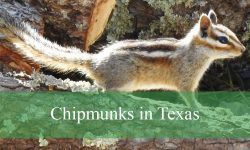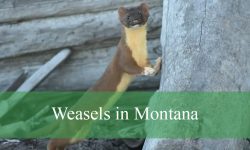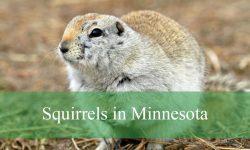During the hot Kansas summers, countless biting, stinging, and irritating insects become especially active. From buzzing mosquitoes to stealthy bed bugs, these tiny creatures can cause discomfort, allergic reactions, or even transmit diseases to humans and pets.
While many insects play vital roles in the ecosystem, some species found across the Sunflower State are more harmful than helpful. Learning how to recognize them can prevent unwanted bites, infestations, and health risks.
In this guide, we’ll explore 25 dangerous bugs in Kansas, complete with pictures and identification details. You’ll discover where they live, how to spot them, and what makes them risky — helping you stay safe both indoors and outdoors.
Most Dangerous Bugs Found in Kansas
Yellow Jackets (Vespula spp.)
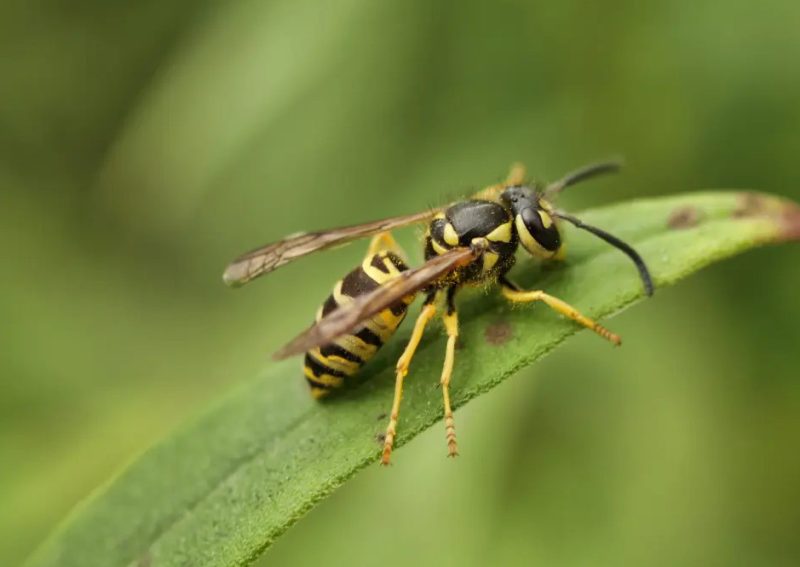
Yellow Jackets are among the most aggressive stinging insects found in Kansas. These wasps are easily identified by their black and yellow striped bodies and narrow waists. Measuring about ½ inch long, they have smooth bodies compared to the fuzzy appearance of bees. Their wings fold lengthwise when at rest, and they fly with rapid, darting movements, often seen hovering around food or trash cans during summer and fall.
These social wasps build paper-like nests made from chewed wood fibers mixed with saliva. Nests are typically found underground, inside wall cavities, or in hollow trees. Colonies can contain thousands of individuals, all working together to defend their queen and brood. Yellow Jackets are omnivorous, feeding on nectar, fruit, and other insects, which makes them both pollinators and predators in the ecosystem.
Behaviorally, Yellow Jackets are extremely territorial. They become especially defensive in late summer when food sources decline and their colony is at its peak population. They will sting repeatedly if they feel threatened, releasing a pheromone that triggers others to join the attack. This coordinated defense makes them one of the most feared insects in the region.
Their sting is intensely painful, causing sharp burning sensations and swelling at the puncture site. The venom contains allergens that can trigger severe systemic reactions, including anaphylaxis, in sensitive individuals. Even those without allergies may experience redness, itching, and tenderness lasting several days.
In Kansas, Yellow Jackets thrive in both rural and urban settings, from grassy fields to picnic areas. Their attraction to sugary drinks and meats makes them a nuisance during outdoor activities. It’s crucial to avoid swatting at them, as sudden movements can provoke an attack. Professional removal is recommended when nests are located near homes or human activity.
Paper Wasps (Polistes spp.)
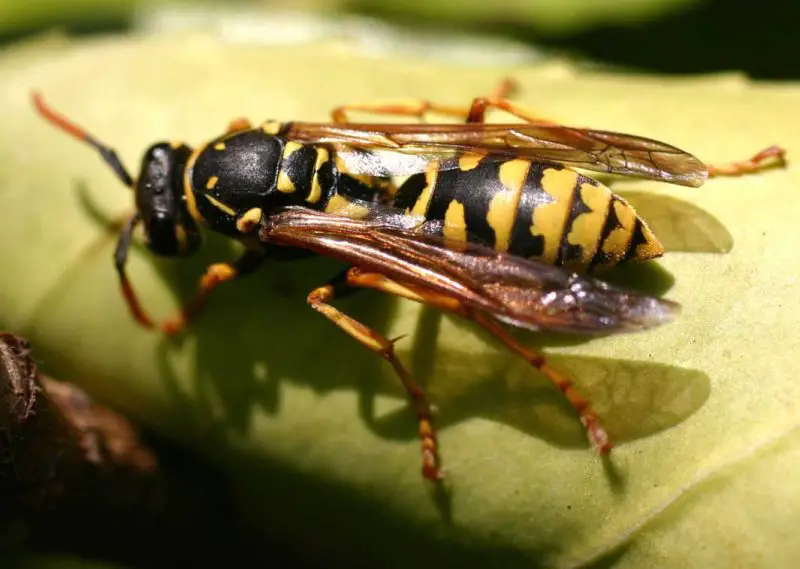
Paper Wasps are slender-bodied insects recognized by their long legs, narrow waists, and reddish-brown or black coloration with yellow markings. They typically measure between ¾ to 1 inch long. Their distinctive nests are open, umbrella-shaped structures made from chewed plant material mixed with saliva, usually attached to eaves, porches, or tree branches.
Unlike Yellow Jackets, Paper Wasps are semi-social, maintaining smaller colonies of only a few dozen workers. Each nest contains multiple open cells where eggs are laid and larvae develop. They feed primarily on nectar and other insects such as caterpillars, making them beneficial garden allies when not disturbed.
In terms of behavior, Paper Wasps are generally less aggressive than other wasps. They only sting when their nest is threatened. However, if a person accidentally brushes against the nest or disturbs it, these wasps will defend it fiercely. They tend to fly slowly and hang their legs down in flight, a characteristic that helps distinguish them from other species.
Their sting is painful but not usually life-threatening. It causes localized swelling, redness, and itching. In sensitive individuals, allergic reactions may occur, including dizziness, difficulty breathing, and swelling of the face or throat. Because their nests are often built close to human dwellings, stings typically happen during routine outdoor activities.
Paper Wasps are widespread across Kansas, preferring warm, sheltered areas for nesting. They thrive in gardens, barns, and under house eaves. Although their presence can be alarming, they play an important role in controlling pest insects. Removing small nests early in the season or using preventative deterrents can minimize conflicts with these beneficial yet defensive insects.
Bald-Faced Hornet (Dolichovespula maculata)
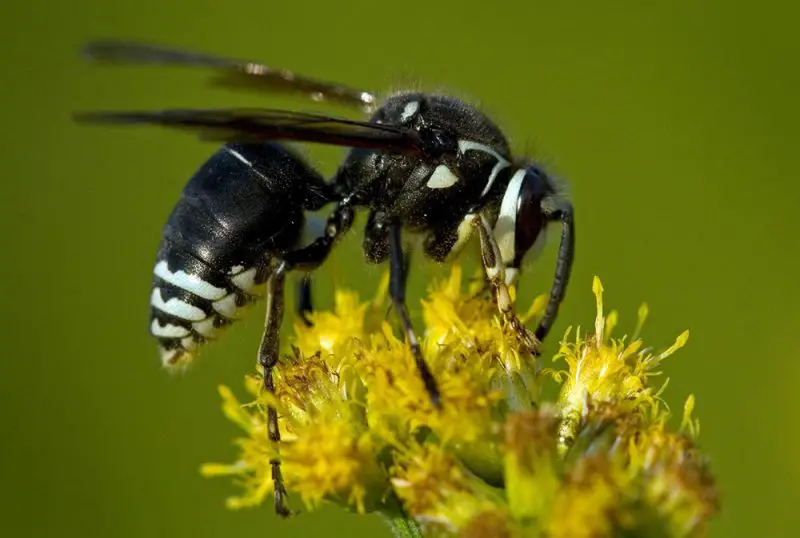
The Bald-Faced Hornet is a large, black-and-white wasp known for its aggressive nature and striking appearance. Despite its name, it is not a true hornet but a type of aerial yellow jacket. Adults range from ¾ to 1 inch in length, with smooth, shiny bodies and distinctive white markings on their faces and abdomens. They are often seen buzzing near trees, shrubs, or structures where they build their large, paper-like nests.
Their nests are football-shaped and suspended from tree branches, roof eaves, or poles. Made from chewed wood fibers, these nests can grow over a foot long and house several hundred wasps. Inside, the queen lays eggs while sterile worker wasps maintain the structure and protect the colony from predators or intruders.
Bald-Faced Hornets are extremely territorial. They will aggressively defend their nests from anything that comes too close. Their stings are more potent than those of typical Yellow Jackets due to a higher concentration of venom. They can sting multiple times, injecting venom that causes intense pain, redness, and swelling. The pain can persist for hours, and allergic individuals may experience severe reactions.
Their venom contains histamines and toxins that can affect the nervous system, leading to systemic reactions in sensitive people. Multiple stings can cause dizziness, difficulty breathing, or even anaphylaxis, requiring immediate medical attention. Because they often nest near homes or wooded areas, encounters are common in late summer.
In Kansas, Bald-Faced Hornets prefer forest edges, suburban neighborhoods, and gardens with flowering plants. They prey on flies, caterpillars, and other insects, making them beneficial predators. However, due to their aggressive defense of nests, removal should only be done by professionals equipped with protective gear.
Honey Bee (Apis mellifera)
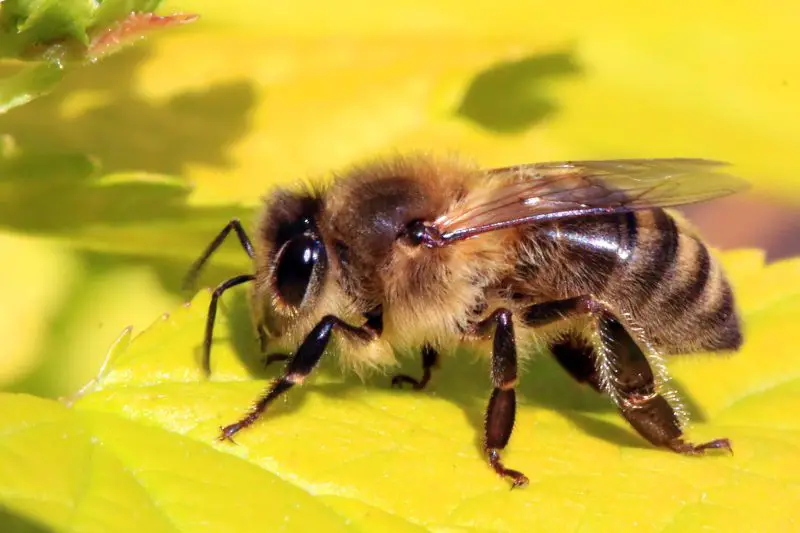
The Honey Bee is a familiar sight in Kansas gardens and meadows, recognized by its golden-brown body with black bands and dense hair that aids in pollen collection. Adult workers measure about ½ inch long. They live in highly organized colonies consisting of one queen, thousands of workers, and drones, housed in hives made of wax combs.
Honey Bees are vital pollinators responsible for fertilizing many crops and wildflowers. They collect nectar and pollen, producing honey and beeswax in the process. Their social structure is complex, with workers performing various roles such as nursing larvae, guarding the hive, and foraging for food.
While Honey Bees are generally gentle, they will sting to defend their hive or when accidentally squeezed. Their stinger is barbed, causing it to lodge in human skin and tear from the bee’s body, leading to the bee’s death. The sting injects venom containing melittin, which triggers sharp burning pain and localized swelling.
Reactions to Honey Bee stings vary. Most people experience short-term discomfort, but those allergic to bee venom can suffer from severe reactions including difficulty breathing, hives, and anaphylaxis. Immediate removal of the stinger and application of ice can reduce pain and swelling, but medical care is essential in serious cases.
In Kansas, Honey Bees thrive in rural and suburban environments. They frequent flowering gardens, orchards, and fields throughout spring and summer. Despite the potential danger of stings, they play an irreplaceable role in agriculture and biodiversity. Protecting their populations through responsible management is essential for maintaining healthy ecosystems.
Bumble Bee (Bombus spp.)
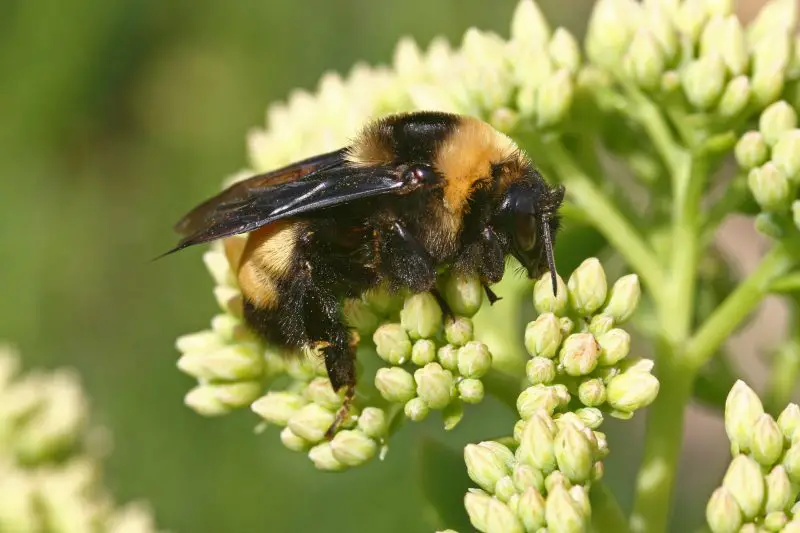
Bumble Bees are large, fuzzy insects with distinctive black and yellow banding and a robust, rounded body. Measuring between ¾ and 1 inch long, they are easily recognized by their loud, buzzing flight and dense hair that helps them collect pollen efficiently. Their wings beat rapidly, allowing them to hover and perform “buzz pollination” — a unique method that shakes pollen loose from flowers.
These bees are social insects that form small colonies in abandoned rodent burrows or grassy clumps. Each colony typically has fewer than 200 individuals, including a single queen. Bumble Bees are active pollinators of wildflowers, tomatoes, and berries, often working in cooler temperatures when other bees remain inactive.
Bumble Bees are generally gentle and non-aggressive. They will only sting when directly handled or when their nest is disturbed. Unlike Honey Bees, their stinger is smooth, allowing them to sting multiple times. Their venom causes sharp pain, redness, and swelling at the site of the sting, but it is rarely dangerous unless the person is allergic.
Although their venom is not as potent as that of wasps, sensitive individuals can develop systemic allergic reactions. The toxins can cause mild tissue irritation, and in rare cases, nausea or dizziness. For most people, pain subsides within a few hours after treatment with ice and antihistamines.
In Kansas, Bumble Bees are commonly found in gardens, meadows, and farmlands. They prefer cool, moist environments with abundant flowers. Because of their crucial role in pollination, they are considered beneficial insects. Avoid disturbing their nests, and they will rarely pose a threat to humans or pets.
Cicada Killer Wasp (Sphecius speciosus)
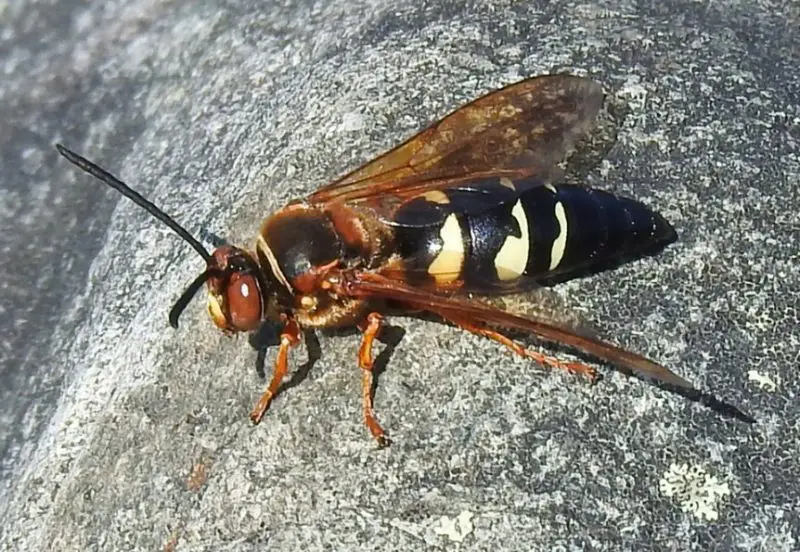
The Cicada Killer Wasp is one of the largest wasps in Kansas, often mistaken for hornets due to its impressive size. Adults measure between 1.3 to 2 inches long, with striking black and yellow markings and rust-colored wings. Their bodies are robust and shiny, adapted for burrowing into the ground. Despite their intimidating appearance, these wasps are solitary and rarely aggressive toward humans.
Cicada Killers get their name from their hunting behavior. Females capture cicadas mid-flight using their strong mandibles and powerful sting, paralyzing them before dragging them into underground burrows. Each burrow may contain several cells, each provisioned with a paralyzed cicada and a single egg. When the larva hatches, it consumes the cicada as its first meal.
These wasps prefer sandy or loose soil for nesting, such as in lawns, gardens, or along sidewalks. Males, which cannot sting, aggressively patrol their territories to ward off other males and potential threats. Their loud buzzing and aerial dives may appear threatening but are harmless displays of defense. Females, while capable of stinging, only do so when handled or provoked.
A Cicada Killer’s sting is painful but not dangerous. The venom is designed for paralyzing cicadas, not for defense against mammals. Human reactions are typically limited to mild pain, redness, and swelling at the site. Allergic reactions are extremely rare, making this wasp far less dangerous than its reputation suggests.
In Kansas, Cicada Killers are active from mid-summer through early fall, coinciding with the emergence of cicadas. They play a minor ecological role in controlling cicada populations. Homeowners often encounter them in sandy yards or gardens, but unless nests become numerous, they are best left alone as beneficial, non-aggressive predators.
Mud Dauber Wasp (Sceliphron caementarium)
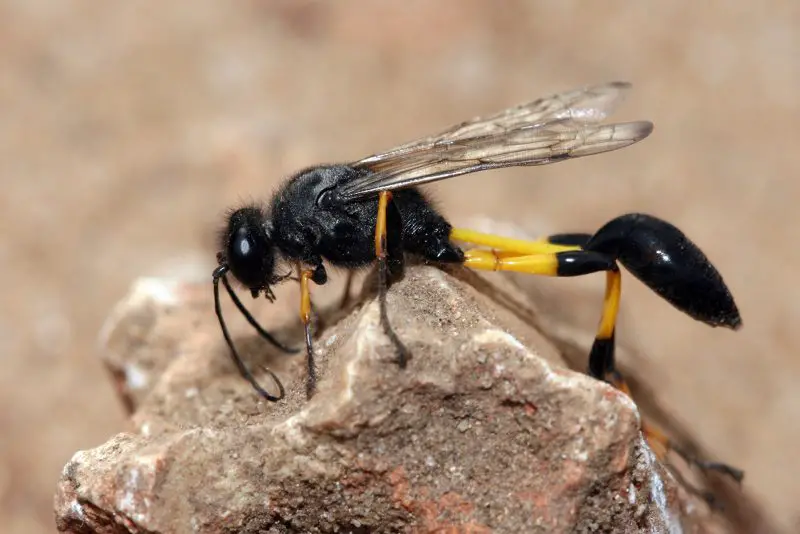
The Mud Dauber Wasp is a slender, black insect with yellow markings and long, thread-like waists connecting the thorax and abdomen. Adults typically measure between ¾ and 1 inch in length. They are named for their unique behavior of building nests out of mud, which they shape into tubular chambers on walls, ceilings, or under eaves.
Mud Daubers are solitary wasps, meaning each female constructs and provisions her own nest. They capture spiders, sting them to induce paralysis, and seal them inside the mud cells along with a single egg. When the larva hatches, it feeds on the immobilized spiders. This natural pest control behavior makes Mud Daubers beneficial around homes and gardens.
These wasps are calm and non-aggressive. They rarely sting, even when disturbed near their nests. Their slow, deliberate flight and tendency to hover around structures often lead people to mistake them for more dangerous species. Males are harmless, as they lack stingers entirely.
The sting of a Mud Dauber is rare and mild, typically resulting in localized pain and slight swelling. Their venom is designed to subdue spiders rather than cause significant harm to humans. However, as with all insect stings, allergic individuals should take precautions and seek medical care if severe symptoms develop.
Mud Daubers are widespread throughout Kansas, nesting in barns, sheds, porches, and attics. They prefer areas near water where mud is available for construction. Their presence indicates a healthy ecosystem, and since they pose little threat to humans, they should generally be tolerated or relocated rather than exterminated.
Fire Ant (Solenopsis invicta)
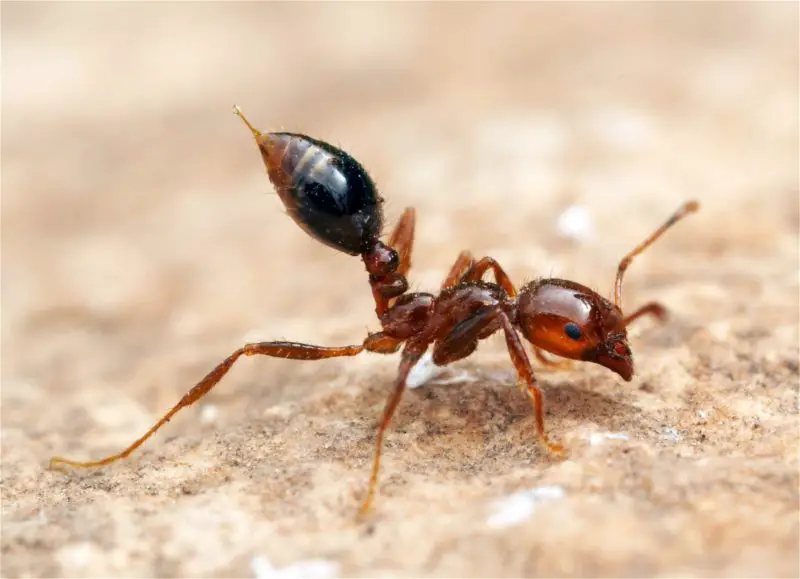
Fire Ants are notorious for their painful stings and aggressive swarming behavior. These reddish-brown ants measure about ⅛ to ¼ inch long and live in large colonies within dome-shaped mounds made of soil. Although native to South America, they have spread into southern parts of Kansas, especially in sunny, open areas such as fields, parks, and lawns.
Each colony contains thousands of worker ants and one or more queens. Fire Ants are omnivorous, feeding on insects, seeds, and even small animals. They become highly aggressive when their mound is disturbed, quickly climbing onto intruders and delivering multiple venomous stings in rapid succession.
The Fire Ant sting is immediately painful, producing a burning sensation followed by itching and the formation of white pustules. Their venom contains alkaloid toxins that damage skin cells and can cause allergic reactions. In severe cases, stings may lead to dizziness, nausea, or life-threatening anaphylaxis, especially if a person is stung multiple times.
Fire Ants are particularly dangerous because they attack in groups. When disturbed, workers release alarm pheromones, triggering others to swarm and sting simultaneously. Pets and livestock are also at risk, as heavy infestations can overwhelm small animals. Their mounds can damage lawns, agricultural fields, and electrical equipment.
In Kansas, Fire Ants are primarily found in the southern and eastern regions but are gradually expanding northward. Control requires a combination of chemical baits and mound treatments. Caution should be exercised when mowing, gardening, or playing near ant mounds to avoid provoking an attack.
Velvet Ant (Dasymutilla occidentalis)
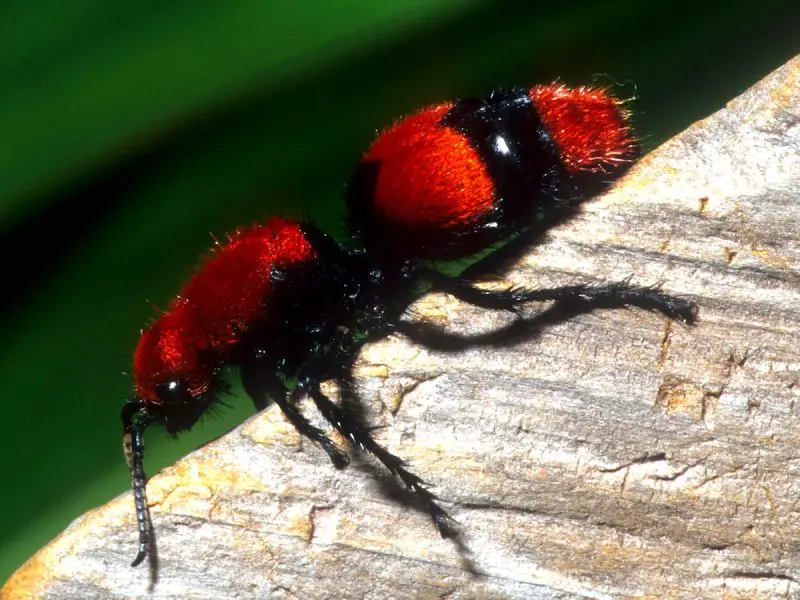
The Velvet Ant, often called the “Cow Killer,” is not a true ant but a wingless wasp. Females are easily recognized by their bright red-orange, velvety hairs covering the body and their strong, armored exoskeleton. Adults measure between ¾ and 1 inch in length, making them among the most striking insects in Kansas. Males have wings and cannot sting, while females are wingless and deliver one of the most painful stings in North America.
These solitary insects do not build colonies. Instead, females wander the ground searching for the underground nests of other wasps or bees. When found, they lay their eggs inside the host’s cocoon. The Velvet Ant larva then consumes the developing host larva, effectively parasitizing it. This parasitic behavior helps control populations of ground-nesting bees and wasps.
Velvet Ants are generally non-aggressive and will only sting when stepped on or handled. However, their sting is extremely painful — sharp, burning, and lasting several minutes. The venom is not lethal but causes intense discomfort, leading to their nickname “Cow Killer.” Their thick exoskeleton makes them difficult for predators to injure or eat.
In addition to their sting, Velvet Ants can emit an audible squeak when threatened. This sound, combined with their bright coloration, serves as a warning to potential predators. They move quickly on the ground and are most active during hot summer afternoons.
In Kansas, Velvet Ants inhabit sandy or grassy areas, especially prairies and open fields. They play an important ecological role as natural regulators of other insect populations. While they look intimidating, they should be observed from a distance rather than harmed, as they rarely pose real danger unless provoked.
Mosquitoes (Aedes and Culex spp.)
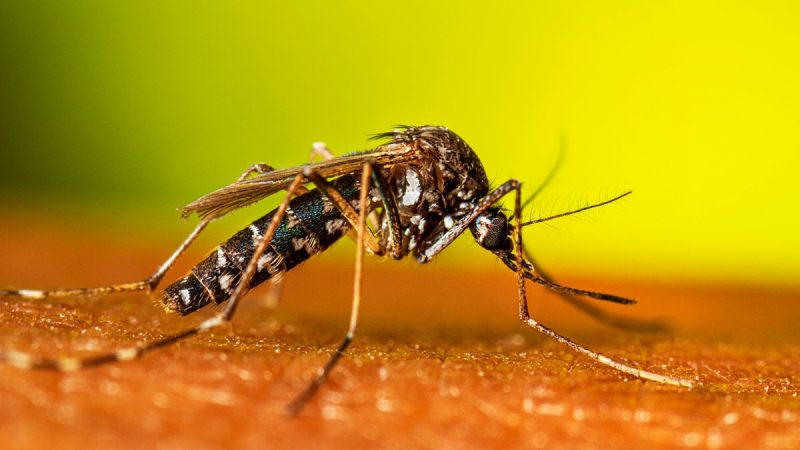
Mosquitoes are among the most common and dangerous insects in Kansas due to their role as disease carriers. These small, slender insects measure between ⅛ and ¼ inch long, with narrow bodies, long legs, and a prominent proboscis used for piercing skin and sucking blood. Only females bite, as they require blood meals to produce eggs, while males feed on nectar.
In Kansas, the most prevalent genera are Aedes and Culex. Aedes mosquitoes, recognizable by their black-and-white striped bodies, are active during the day and are known vectors of diseases such as Zika virus and dengue fever in warmer regions. Culex mosquitoes, which are brown and more nocturnal, can transmit West Nile virus, a disease that occasionally causes severe neurological symptoms in humans.
Mosquitoes breed in standing water — anything from ponds and ditches to flowerpots and clogged gutters. Females lay eggs on or near water surfaces, and larvae develop rapidly in warm, stagnant conditions. Their populations surge after rainfall and during humid summer months in Kansas.
Mosquito bites cause small, itchy welts due to an allergic reaction to their saliva, which contains anticoagulants. Excessive scratching can lead to skin infections. More seriously, mosquito-borne diseases can cause fever, fatigue, encephalitis, or in rare cases, death. Pets are also at risk, as mosquitoes transmit heartworm to dogs and cats.
Preventing mosquito bites involves using repellents containing DEET, wearing long clothing outdoors, and eliminating standing water around homes. Mosquitoes are not only a nuisance but also a legitimate public health concern across Kansas, making consistent prevention measures vital during the warm months.
Deer Flies (Chrysops spp.)
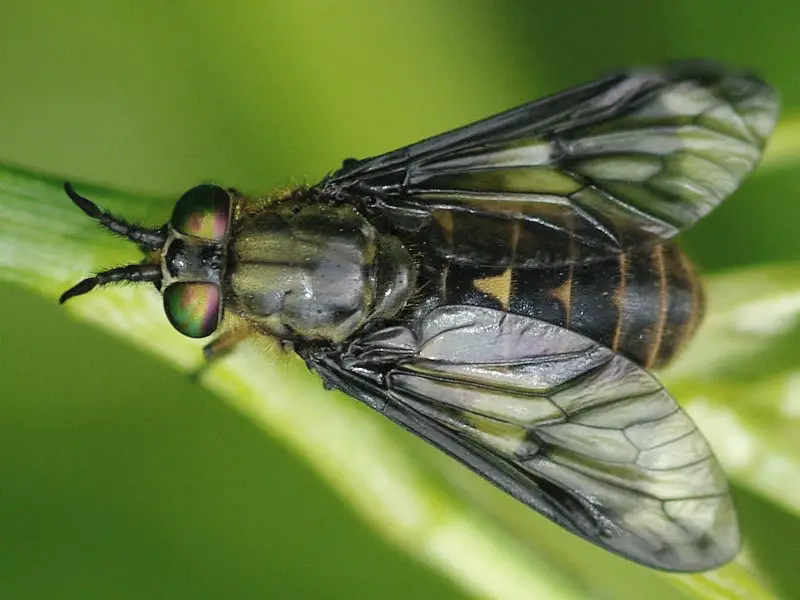
Deer Flies are small, stout-bodied insects with strikingly patterned wings and large, brightly colored eyes. Typically measuring between 6 to 10 millimeters in length, these flies are easily identified by their yellowish or gray bodies and clear wings marked with dark bands. Females possess sharp, blade-like mouthparts that slice the skin to feed on blood, while males primarily consume nectar.
These flies are notorious for their relentless pursuit of both humans and animals during outdoor activities. They are most active on warm, sunny days near wooded areas, marshes, or bodies of water where they breed. Their flight is fast and erratic, making them difficult to swat away once they have locked onto a target.
Deer Flies are most common in Kansas during late spring and throughout the summer months. They are attracted by movement, carbon dioxide, and body heat, which is why they often swarm around the head and neck. Their populations thrive in moist environments, particularly around livestock farms and forest edges.
The bite of a Deer Fly is extremely painful because of the cutting action of its mouthparts. The wound often bleeds freely and can cause intense itching, redness, and swelling afterward. Some people may experience allergic reactions or secondary infections if the area is scratched excessively.
In addition to irritation, Deer Flies are known vectors of tularemia (rabbit fever), a potentially serious bacterial disease that can infect humans. Although cases are rare in Kansas, the possibility of transmission makes avoiding bites essential. Wearing protective clothing and insect repellent can help reduce encounters during their peak season.
Stable Flies (Stomoxys calcitrans)
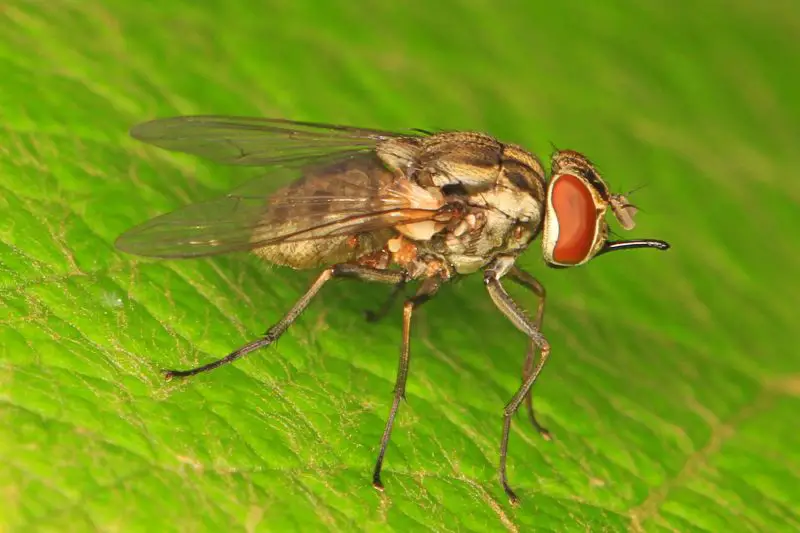
Stable Flies are nearly identical in appearance to common houseflies but can be distinguished by their forward-pointing piercing mouthparts. Adults are about 6 to 8 millimeters long, gray in color, with dark spots on their abdomen. Both males and females feed on blood, making them more aggressive and painful than typical nuisance flies.
These flies prefer to inhabit barns, stables, and livestock areas, where they lay their eggs in decaying organic matter such as hay, manure, and wet straw. In Kansas, they are especially abundant during the late summer months when warm, humid conditions support their breeding cycle.
Stable Flies are strong fliers and often attack the legs and lower body of animals and humans. Their persistent biting behavior can cause extreme discomfort, restlessness, and reduced feeding in cattle and horses, leading to weight loss and decreased milk production.
The bite of a Stable Fly is sharp and painful, often leaving small red welts that itch and may become inflamed. While they do not usually transmit diseases to humans, their bites can introduce secondary infections if scratched. For livestock, they can spread blood-borne pathogens and parasitic infections between animals.
Controlling Stable Fly populations in Kansas involves proper waste management, sanitation around animal facilities, and insecticide treatments when necessary. Removing breeding material like decaying hay or manure can significantly reduce infestations and protect both humans and animals from their painful attacks.
Kissing Bug (Triatoma sanguisuga)
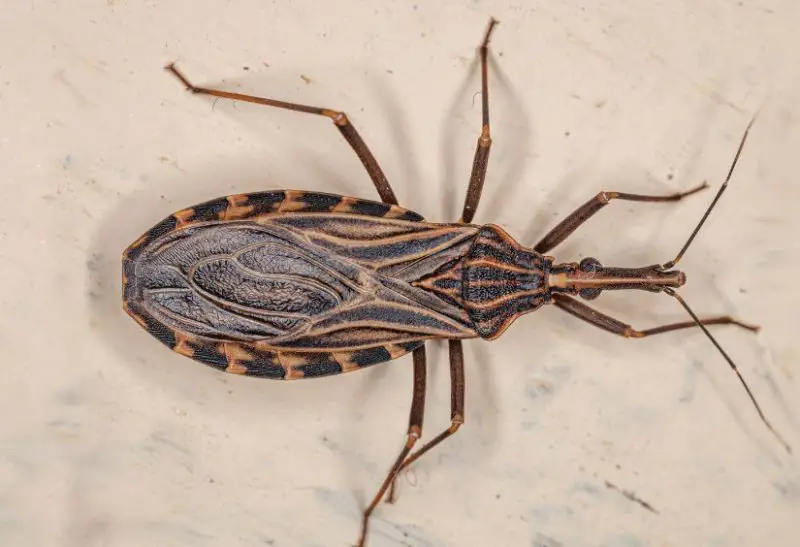
The Kissing Bug, also known as the Eastern Bloodsucking Conenose, is a dark brown or black insect with orange or red edges along its abdomen. Adults measure about 2 to 3 centimeters long and have elongated, cone-shaped heads with a distinct long beak used for piercing skin and sucking blood.
These bugs are nocturnal and typically hide during the day in cracks, under rocks, or in rodent nests. In Kansas, they are sometimes found around rural homes or barns, especially in areas with wildlife like raccoons or opossums. Their nickname comes from their tendency to bite humans near the mouth or eyes while they sleep.
The Kissing Bug’s bite is usually painless at first but often leads to redness, itching, and swelling. The main health concern associated with this insect is its potential to transmit Chagas disease, caused by the parasite Trypanosoma cruzi. While transmission is extremely rare in Kansas, the bug’s feces can contaminate the bite site, allowing infection to occur if rubbed into the skin.
In most cases, bites result in local allergic reactions rather than serious illness. However, some people develop severe swelling or anaphylaxis after multiple exposures. Maintaining clean, sealed living spaces and reducing rodent presence can help prevent encounters.
Despite their menacing appearance, Kissing Bugs in Kansas are not considered a widespread health threat. Still, identification and avoidance are essential, especially in rural settings where they are occasionally spotted near light sources at night.
Assassin Bugs (Other Species)
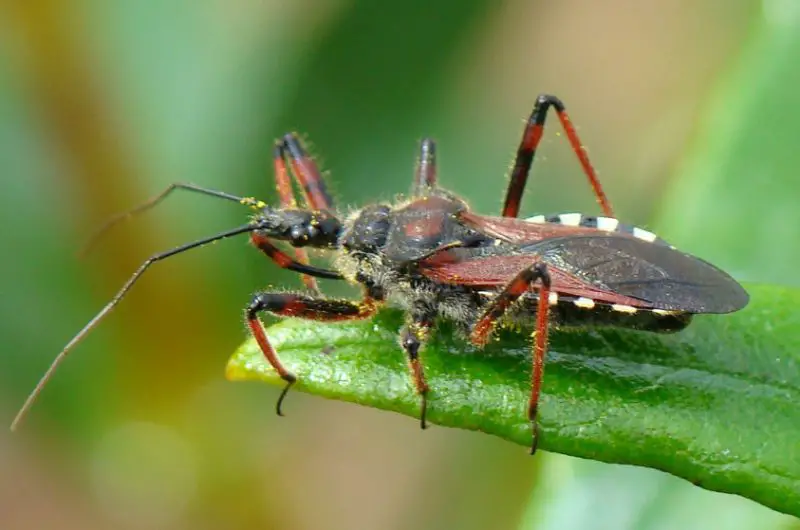
Assassin Bugs are a diverse group of predatory insects belonging to the Reduviidae family. They are typically black or brown with elongated heads, narrow bodies, and curved, needle-like mouthparts used to inject paralyzing saliva into their prey. Most species in Kansas range from 10 to 25 millimeters in length and are valuable in controlling pest populations.
These insects are commonly found in gardens, fields, and wooded areas, where they prey on other insects like caterpillars, beetles, and aphids. They move slowly but strike quickly, using their strong front legs to capture and immobilize prey before feeding.
Although Assassin Bugs are beneficial to the ecosystem, they can deliver a painful bite if handled or threatened. Their saliva contains enzymes that cause intense burning and swelling, often compared to a bee sting. The affected area may remain tender for several days, especially in sensitive individuals.
Most Assassin Bugs in Kansas do not transmit disease to humans, but their bites can trigger allergic reactions or secondary skin infections. It is best to admire them from a distance and avoid direct contact, particularly when working in the garden or handling plants where they may hide.
By helping to control other pest insects naturally, Assassin Bugs play an important ecological role. However, their defensive bite reminds humans that even beneficial species should be respected and left undisturbed.
Blister Beetles (Epicauta spp.)
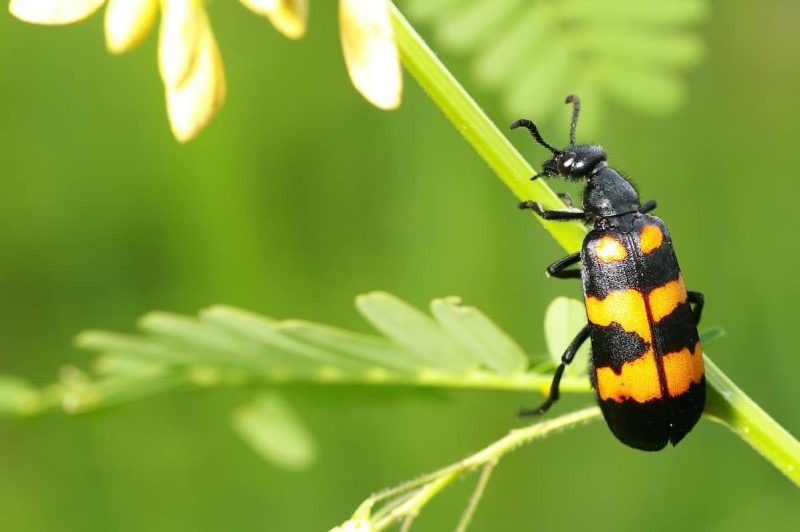
Blister Beetles are elongated insects with soft, flexible bodies and narrow necks, usually measuring 1 to 2.5 centimeters long. They come in various colors, including black, gray, or striped, and are easily recognized by their slender shape and drooping antennae. In Kansas, the most common species are found in alfalfa fields and on flowering plants.
These beetles release a toxic chemical called cantharidin when threatened or crushed. Contact with the skin causes painful blisters and irritation, which gives them their name. Cantharidin is also toxic if ingested, posing a serious threat to livestock such as horses that accidentally consume contaminated hay.
Blister Beetles are most active during late spring and summer, feeding on leaves, blossoms, and other soft plant materials. They are especially abundant during hot, dry periods and can appear suddenly in large numbers, causing significant agricultural damage.
For humans, direct skin contact with Blister Beetles can result in blistering, redness, and burning sensations. In severe cases, eye or mucous membrane exposure can lead to more serious inflammation. Livestock poisoning is a greater concern, as even small quantities of cantharidin can be lethal.
Preventing contact with Blister Beetles involves wearing gloves when handling hay or plants and avoiding crushing them with bare hands. Farmers in Kansas carefully inspect alfalfa before harvest to prevent contamination and protect animals from accidental poisoning.
Chiggers (Trombicula alfreddugesi and Related Mites)
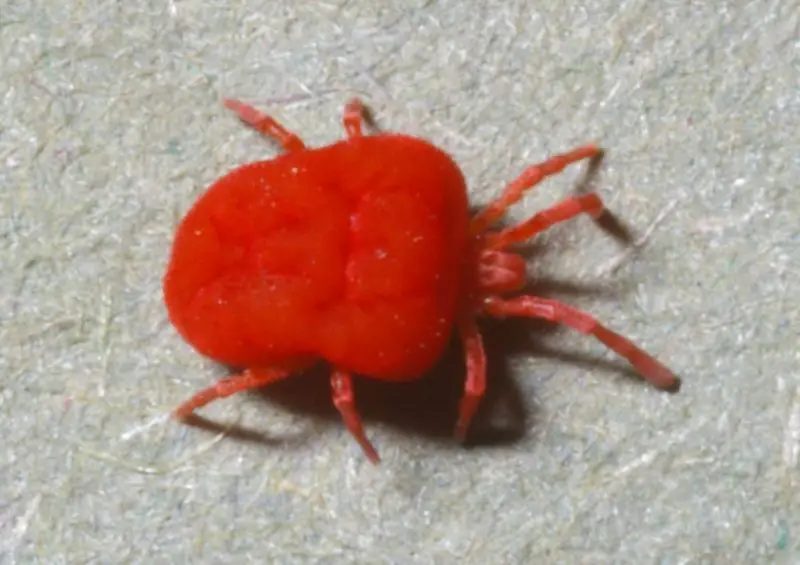
Chiggers are the larval stage of certain mite species and are so tiny—about 1/150 of an inch—that they are nearly invisible to the naked eye. These bright red or orange larvae live in grassy, brushy, or wooded areas and are most active in the warm months of late spring through early fall in Kansas. Despite being mites, they are often referred to as “bugs” due to their biting behavior.
When a chigger attaches to the skin, it pierces the outer layer and injects digestive enzymes that break down skin cells. It does not suck blood but instead consumes liquefied tissue. The bite is painless at first but soon develops into intense itching and red, raised welts that can last for several days.
Chigger bites are often concentrated around tight clothing areas such as the waistline, ankles, or behind the knees. The itching can be severe and persistent, leading to scratching that may cause secondary bacterial infections. However, chiggers in Kansas do not transmit diseases to humans, unlike some tropical species.
These mites thrive in humid environments with dense vegetation, such as tall grass, shaded trails, and forest edges. Outdoor enthusiasts and farmers are especially prone to exposure. Taking preventive steps like wearing long pants, using insect repellent, and showering promptly after outdoor activity helps reduce the risk of bites.
While chigger bites are more of an irritation than a medical threat, their effect can be extremely uncomfortable. Topical antihistamines or corticosteroid creams can help relieve itching and inflammation until the skin heals naturally within a week.
Bed Bugs (Cimex lectularius)
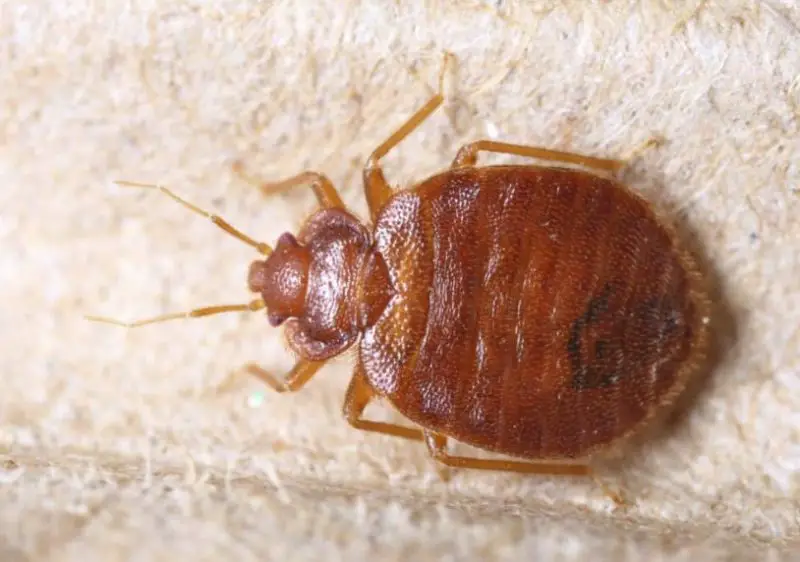
Bed Bugs are small, flat, reddish-brown insects about 5–7 millimeters long. They are wingless and adept at hiding in mattress seams, furniture cracks, and baseboards. These nocturnal pests feed exclusively on blood, usually emerging at night to bite exposed skin while people sleep.
Their bites typically appear in rows or clusters of small, red welts accompanied by itching or burning sensations. Although Bed Bugs are not known to transmit diseases, their infestations can cause significant psychological distress, allergic reactions, and loss of sleep due to constant irritation.
In Kansas, Bed Bugs are common in homes, hotels, dormitories, and shelters. They spread easily through luggage, clothing, and secondhand furniture, making eradication difficult without professional pest control. Their resilience and ability to survive months without feeding make them one of the most persistent household pests.
Bed Bug bites often resemble those of mosquitoes or fleas, but the pattern of linear clusters is a key identifying feature. While some people experience little to no reaction, others may develop severe swelling or blister-like lesions.
Preventing Bed Bug infestations involves regular inspection of bedding and furniture, washing linens at high temperatures, and vacuuming frequently. Once established, extermination typically requires heat treatment or chemical control by professionals to eliminate all life stages from eggs to adults.
Fleas (Ctenocephalides felis and Pulex irritans)
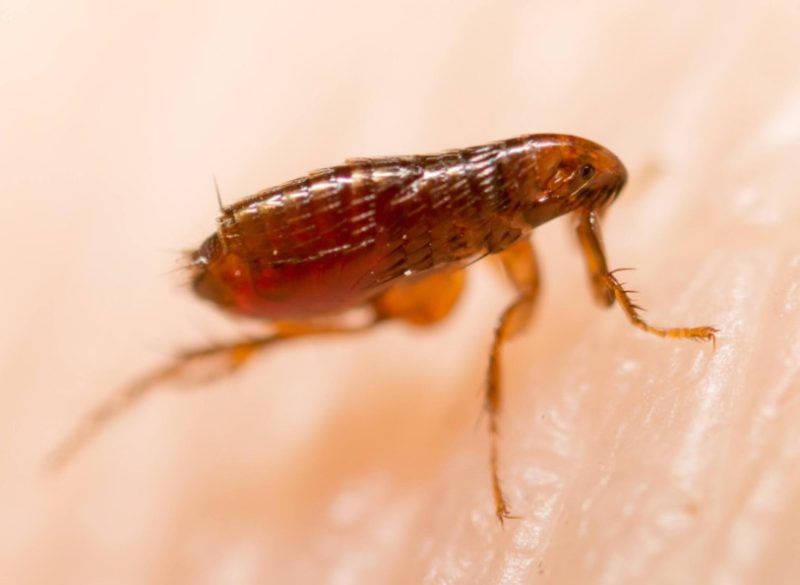
Fleas are small, wingless, dark-brown insects, about 1/8 inch long, with flattened bodies adapted for jumping and clinging to hosts. Their long hind legs enable them to leap impressive distances—up to 200 times their body length—allowing them to move easily between animals and humans.
In Kansas, the cat flea (Ctenocephalides felis) is the most common species, infesting pets like cats and dogs, while the human flea (Pulex irritans) occasionally bites people. Both species feed on blood and leave behind itchy, red, swollen bumps that can become infected if scratched excessively.
Fleas are notorious for spreading diseases such as murine typhus and bubonic plague in certain regions, although such cases are extremely rare in Kansas. More commonly, they transmit tapeworms to pets and can trigger allergic dermatitis in sensitive individuals.
Flea infestations often begin with pets but quickly spread throughout carpets, bedding, and upholstery. Their eggs and larvae thrive in warm, humid conditions, making summer the peak season. Regular vacuuming, washing pet bedding, and using veterinarian-approved flea treatments are essential for control.
Though tiny, fleas are among the most irritating pests found in Kansas households. Their rapid breeding cycle and ability to survive for months without a host make them a persistent problem unless treated aggressively at all life stages.
Ticks (Dermacentor variabilis, Amblyomma americanum, etc.)
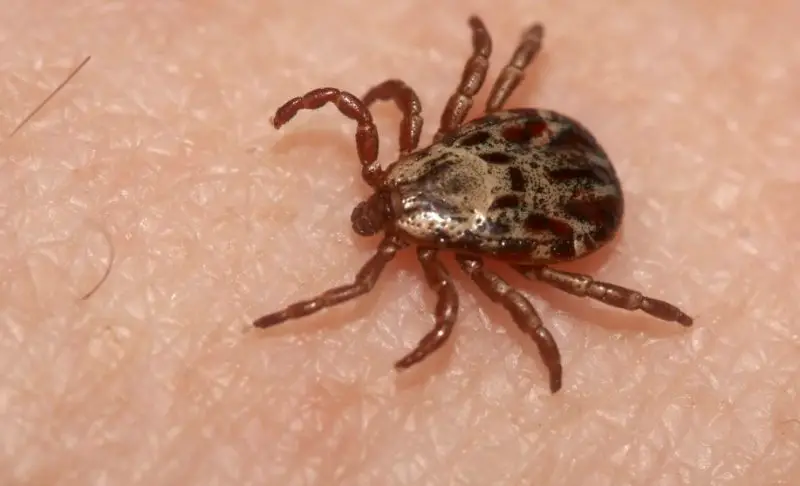
Ticks are small arachnids, not insects, but are commonly called “bugs” due to their biting behavior. In Kansas, the most common species include the American Dog Tick (Dermacentor variabilis), Lone Star Tick (Amblyomma americanum), and Blacklegged Tick (Ixodes scapularis). They vary in size from pinhead-sized nymphs to adult females that can reach 1/4 inch when engorged with blood.
Ticks live in tall grass, brush, and wooded habitats, waiting for animals or humans to pass by so they can attach and feed. Once latched onto the skin, they embed their mouthparts deeply, making removal difficult. Their bites are often painless, but prolonged feeding can cause local irritation, swelling, and itching.
The greatest danger from ticks lies in disease transmission. Kansas ticks can carry pathogens that cause Rocky Mountain spotted fever, Ehrlichiosis, and Tularemia. Symptoms may include fever, rash, muscle pain, and fatigue, requiring prompt medical treatment to prevent complications.
Ticks are most active in spring and early summer when temperatures are mild and humidity is high. Pets and people who spend time outdoors in rural or wooded areas face the highest risk of bites. Wearing light-colored clothing, using repellents, and checking the body after outdoor activities are effective preventive measures.
While most tick bites are harmless, early detection and proper removal are crucial. A tick should be grasped with fine tweezers and pulled straight out without twisting. Monitoring the bite site for redness or fever afterward helps ensure timely medical attention if an infection develops.
Oak Leaf Itch Mite (Pyemotes herfsi)
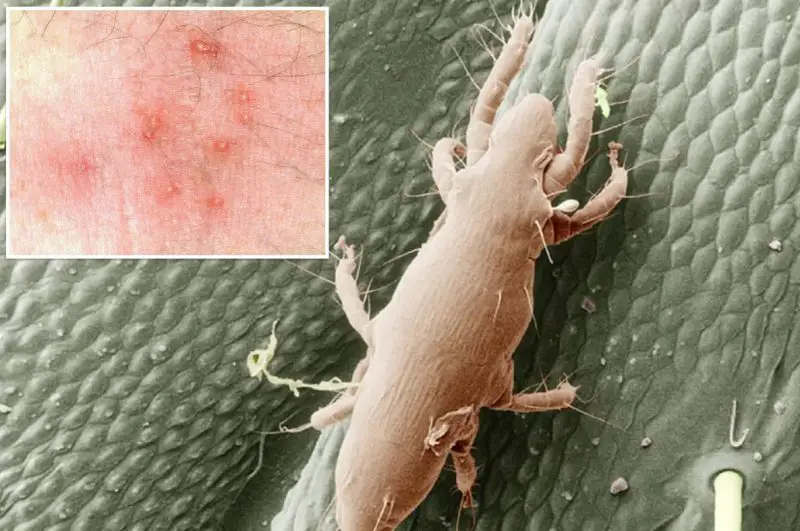
The Oak Leaf Itch Mite is a microscopic parasitic mite that has become infamous in Kansas for causing mysterious outbreaks of itchy rashes during late summer and fall. Invisible to the naked eye, these mites measure only about 0.2 millimeters long and are most active when oak trees are infested with gall-forming midges.
These mites feed on midge larvae inside oak leaf galls but occasionally drop from infested trees in massive numbers. When they come into contact with humans, they bite exposed skin, usually on the neck, arms, and face. The bites produce red, raised welts that can develop within 10–16 hours and cause intense itching for several days.
Unlike mosquitoes or ticks, Oak Leaf Itch Mites do not transmit diseases. However, their bites can be extremely irritating and lead to secondary infections from scratching. The rashes often appear in clusters and can resemble those caused by chiggers or bed bugs, making them difficult to diagnose without expert identification.
Outbreaks are most common in Kansas during dry, windy weather in late summer when mites fall from oak trees onto people below. They are particularly prevalent in parks, schoolyards, and residential areas with mature oak trees.
Preventing bites involves avoiding prolonged exposure under infested trees, especially during windy conditions. Using insect repellent, wearing long-sleeved clothing, and showering after outdoor activities can reduce the severity of outbreaks. Although the itching can be severe, topical treatments and antihistamines typically provide relief until the irritation subsides naturally.
Lice (Pediculus humanus, Pthirus pubis)
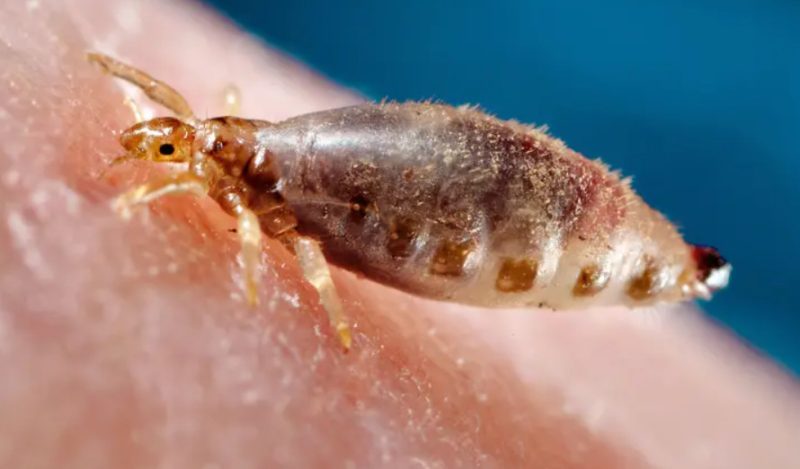
Lice are small, wingless parasitic insects that feed exclusively on human blood. Three types infest people: the head louse (Pediculus humanus capitis), the body louse (Pediculus humanus humanus), and the pubic louse (Pthirus pubis). Each type targets a different area of the body but shares a similar oval shape and size, ranging from 2 to 4 millimeters long.
Head lice are the most common in Kansas, spreading primarily among children through direct contact or shared personal items like hats, brushes, or bedding. Body lice are less frequent but associated with poor hygiene or overcrowded living conditions. Pubic lice, or “crabs,” spread through sexual contact and infest coarse hair on the body.
Lice bites cause intense itching and irritation due to an allergic reaction to their saliva. Persistent scratching can lead to sores and secondary bacterial infections. Body lice are the only type known to transmit diseases such as trench fever and epidemic typhus, though such cases are extremely rare in the U.S.
Infestations are identified by visible lice or their white eggs (nits) attached to hair shafts or clothing fibers. Lice cannot jump or fly—they crawl from one host to another, making close contact the primary mode of transmission.
Treatment involves using medicated shampoos containing permethrin or pyrethrins, washing clothing and bedding in hot water, and thorough combing to remove nits. Maintaining good hygiene and avoiding the sharing of personal items are the best preventive measures against lice infestations.
Carpet Beetles (Anthrenus verbasci)
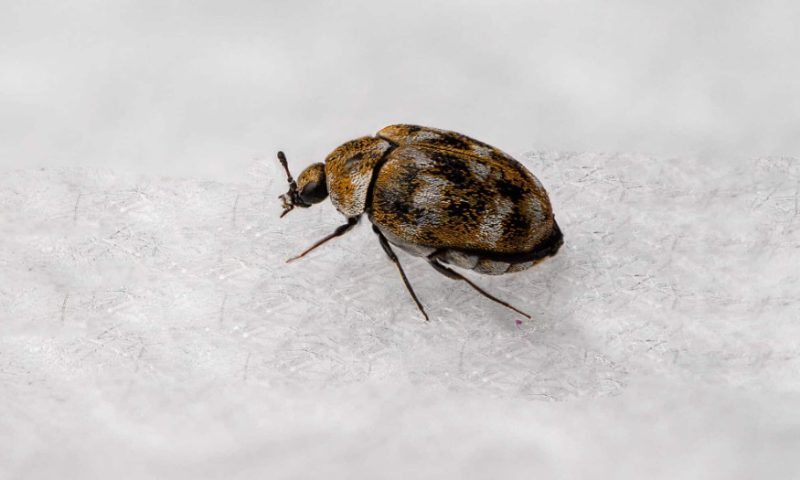
Carpet Beetles are small, oval-shaped insects measuring about 2 to 4 millimeters long. Adults have distinctive mottled coloration of black, white, and brown scales, giving them a speckled appearance. While adult beetles primarily feed on pollen and nectar, their larvae are the real household threat in Kansas homes.
The larvae, known as “woolly bears,” are brown, fuzzy, and covered with tiny hairs. They feed on natural fibers such as wool, silk, fur, and feathers, often damaging carpets, clothing, upholstered furniture, and stored fabrics. Infestations are typically discovered when damage becomes visible or when larvae shed their skins near baseboards and closets.
Carpet Beetles thrive in dark, undisturbed areas like attics, air vents, and under furniture. They can also infest bird or rodent nests near homes, which serve as breeding sites. Adults often enter through open windows during spring and early summer when attracted to light.
Although they do not bite or transmit diseases, Carpet Beetles can cause allergic reactions in sensitive individuals. Contact with larval hairs may produce red, itchy welts that mimic insect bites. These reactions are due to irritation rather than venom or pathogens.
Preventing infestations requires regular vacuuming, cleaning fabrics, and storing clothes in sealed containers. For heavy infestations, professional pest control and inspection of potential animal nests are recommended to eliminate the source and prevent reinfestation.
Cockroaches (Blattella germanica, Periplaneta americana)
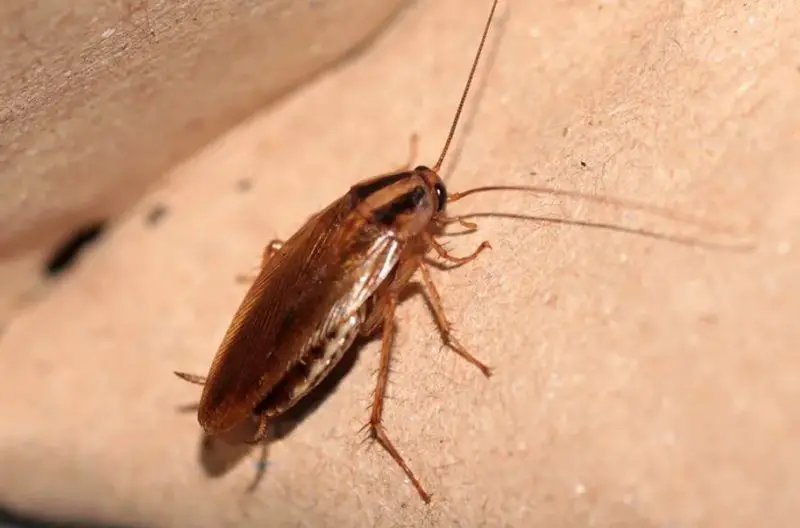
Cockroaches are among the most resilient and troublesome pests in Kansas. The two most common species are the German Cockroach (Blattella germanica), which is small and prefers indoor environments, and the American Cockroach (Periplaneta americana), which is larger and often found in basements, sewers, a
The German Cockroach measures about 1.5 centimeters long, light brown with two dark stripes on its pronotum, while the American species can reach over 4 centimeters and has a reddish-brown body with a yellowish border on its thorax. Both are nocturnal and extremely fast-moving, feeding on crumbs, grease, and organic waste.
Cockroaches are highly adaptable and reproduce quickly, with females laying dozens of eggs at a time. Infestations can develop rapidly in homes, restaurants, or anywhere food and moisture are available. They are most active in warm, humid environments and often hide in cracks, crevices, and kitchen appliances.
Their presence poses significant health risks. Cockroaches contaminate food and surfaces with bacteria such as Salmonella and E. coli, potentially leading to food poisoning. Their shed skins and droppings also trigger allergies and asthma, particularly in children and the elderly.
Eliminating cockroaches requires a combination of sanitation, exclusion, and professional pest control. Sealing entry points, reducing clutter, and using bait or insect growth regulators are effective strategies. Regular cleaning and moisture control are essential to keeping Kansas homes roach-free.
Stink Bugs (Halyomorpha halys)
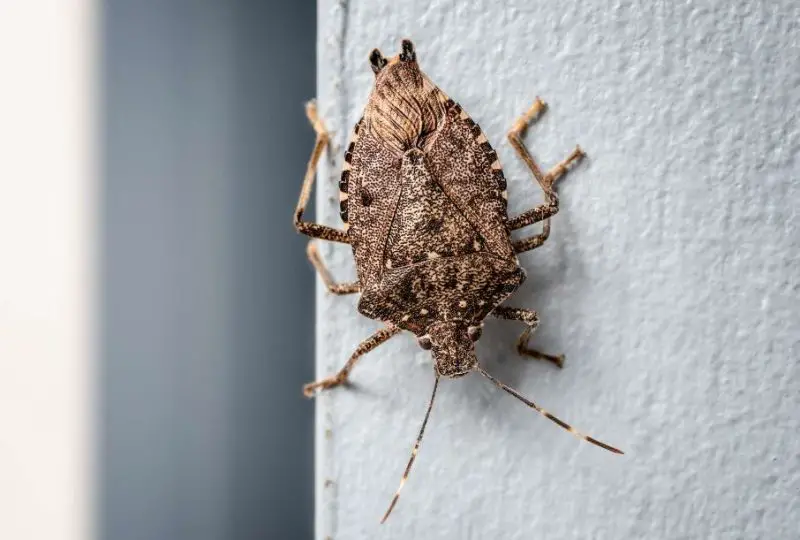
The Brown Marmorated Stink Bug is an invasive species originally from Asia that has become a widespread pest in Kansas. Adults are shield-shaped, mottled brown or gray, and measure about 12 to 17 millimeters long. They are named for the pungent odor they release when disturbed or crushed, a defensive chemical that deters predators.
Stink Bugs are primarily plant feeders, using their piercing-sucking mouthparts to damage fruits, vegetables, and ornamental plants. In Kansas, they are known to infest crops such as soybeans, corn, and apples, causing discoloration and deformities. They are most active from late spring through fall, seeking shelter indoors as temperatures drop.
While they do not bite or sting, their presence inside homes can be a major nuisance. They enter through cracks, vents, and windows in autumn to overwinter, often congregating in large numbers in attics or wall voids. Their odor can linger for days if squashed, making vacuuming a better removal method.
Stink Bugs do not transmit diseases or pose direct health risks, but their odor and secretions can trigger mild allergic reactions in sensitive individuals. They can also stain fabrics and walls when crushed.
Preventing infestations involves sealing entry points around doors, windows, and siding before fall. Homeowners in Kansas often use screens, caulk, and door sweeps to keep these persistent insects out. While mostly a nuisance, their growing population makes them one of the state’s most notable invasive “bugs.”
FAQs About Common Bugs in Kansas
What are the most common household bugs in Kansas?
Some of the most common bugs found in Kansas homes include cockroaches, carpet beetles, stink bugs, lice, and oak leaf itch mites. These pests can cause anything from mild irritation and allergic reactions to property damage or infestations if left unchecked.
Are oak leaf itch mites dangerous to humans?
While oak leaf itch mites don’t spread diseases, their bites can cause severe itching, red welts, and discomfort lasting several days. They often appear in late summer or early fall, especially in areas with oak trees.
How can I prevent lice infestations?
To prevent lice, avoid sharing combs, hats, or bedding, and wash clothing and linens in hot water if an infestation occurs. Regular head checks and good personal hygiene are key to early detection and prevention.
What damage do carpet beetles cause?
Carpet beetles feed on natural fibers such as wool, silk, and leather. Their larvae can damage clothing, upholstery, and stored fabrics. Frequent vacuuming and storing clothes properly can help control them.
How can I get rid of cockroaches effectively?
Eliminate food and water sources, seal entry points, and keep kitchens clean. Using baits, traps, and professional pest control treatments is often necessary to fully remove infestations.
Why do stink bugs enter homes?
Stink bugs often invade homes in the fall to find warmth and shelter during the cold months. Although they don’t bite or cause structural damage, they release a foul odor when crushed or disturbed.
When is the best time to watch for outdoor bugs in Kansas?
Bugs are most active from late spring through early fall when temperatures are warm. Tall grasses, wooded areas, and around homes are prime locations to observe or avoid them, depending on the species.

